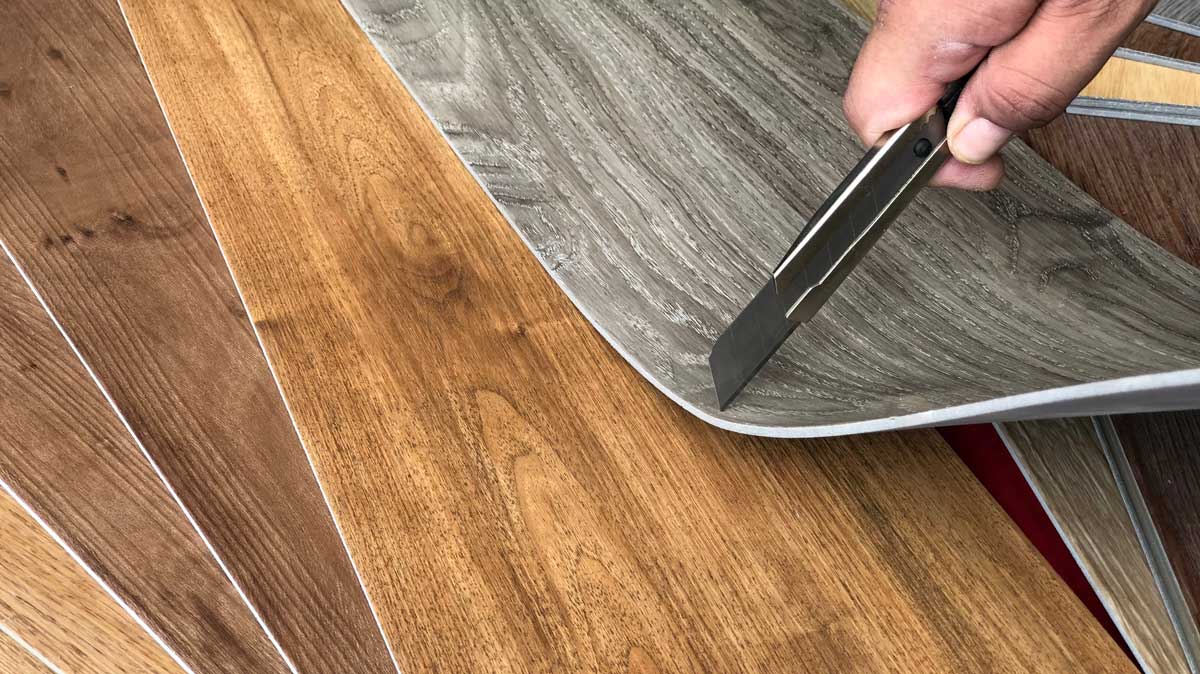Cost to Install Vinyl Flooring – 2025 Price Guide
Vinyl is once again a popular option for flooring due to its durability, stylish looks, and reasonable cost. Vinyl flooring is easy to install and comes in many different types, making it a popular choice for many settings.
Keep reading to learn more about the cost to install vinyl flooring.
2025 Vinyl Flooring Costs
Calculate local project costs by entering your zip code.
Custom Location
| Typical Price Range | $800 - $1,000 |
| Minimum Price | $400 |
| Maximum Price | $2,000 |
| Typical Price Range (per square foot - installed) | $4 - $5 |
Get free estimates from contractors near you.
On this page:
How Much Does Vinyl Flooring Cost?
Vinyl flooring has come a long way since its inception. It used to be available mainly in large sheets with noisy patterns and colors or tiles that were often made with asbestos.
Reminiscent of a bygone era, traditional vinyl flooring is often perceived as dated or old-fashioned in today’s contemporary homes.
However, the vinyl of today is not like the vinyl of the seventies or eighties. The styles available are now more attractive and water-resistant than ever before, and it is now available in floating tiles and planks as well as large sheets and glue-down tiles.
Vinyl is one of the most affordable types of flooring, and the project often costs in the $800 – $1,000 range for a 200 sq. ft. installation. Read on to learn more about how much it costs and what impacts the price.

Why Choose Vinyl?
Wood patterns are a popular choice for consumers as vinyl is one of the least expensive ways to achieve a wood look. If you’re keen to cover your floors in something that looks like wood, vinyl is often the most competitive in terms of price over both laminate and hardwood flooring.
Moreover, vinyl flooring is no longer a cheap or tacky option suitable for those with the lightest wallet. Instead, it is genuinely a competitor for more expensive types of flooring due to its resurgence on the market.
One of the main problems with vinyl flooring was the fact that it was made with asbestos, which gave it a bad reputation for many years. In addition, glue-down vinyl sheets and tiles were extremely difficult to remove once down, as the glue got stronger with age.
The vinyl itself wasn’t very durable, so the surface would wear, but it was near impossible to get it off again. However, contemporary manufacturers have really upped their game, and today’s vinyl is safe, very durable, and easy to install and uninstall.
As such, if you want flooring that is affordable, durable, resistant to water, good for soundproofing, and available in tasteful colors and patterns, vinyl may be the choice for you.
The only real downside to vinyl is the fact that it doesn’t last as long as other materials. If you’re looking for a wood or stone look flooring, vinyl only lasts 20 years on average, while wood, stone, and tile floors can last for hundreds of years when maintained properly.
It’s clear that the arguments for vinyl are quite persuasive, and the main reason you might not want to try it out is simply a matter of personal taste. If this doesn’t deter you, vinyl flooring may certainly appeal to your ambition for a home that is cost-effective to decorate and easy to maintain.
Still, even though it may be more affordable than other types of flooring, you will still want to get a ballpark figure for the room, or rooms, you intend to use it in. Here are some factors and cost calculations that will help you determine the cost of a vinyl floor:
Size of the Room
The size of the floor you need to cover will always impact the overall cost, no matter what flooring you choose. To estimate the flooring material needed, measure the length and width of the floor area. Rooms that have an uneven shape will require extra calculations to either subtract or add to a standard rectangle or square area.
It is much easier to treat the room as a number of imaginary squares and calculate as such. To find the rectangle square footage, multiply the length by the width. The result of this multiplication is known as the square footage, or area, of the floor.
Vinyl flooring costs between $2 and $15 per square foot installed, depending on the type and method of installation. Luxury vinyl planks and tiles often cost the most, while sheet vinyl and peel-and-stick tiles are often lower in cost.
Vinyl Flooring Brand and Guarantee
The brand of the vinyl floor will add to or subtract from its cost. The specific features and the length of the guarantee will also impact the overall price. Vinyl flooring with a stronger guarantee and longer warranty will often cost more.
Because of this, consider the importance of brand and warranty when you’re selecting a floor.
Some brands will also specialize in Luxury Vinyl, while others primarily make composite tile and sheet vinyl. These variations can account for a large difference in price as well.
Professional Flooring Installer
One of the key elements to installing vinyl flooring seamlessly and professionally is to simply hire a professional. There are many things around the house that can be done yourself, but unless you have experience in this area, it’s highly recommended you hire a contractor to install your vinyl flooring for one key reason.
The finished look of a vinyl floor depends largely on the surface underneath it. The surface underneath must be as smooth as possible when using glue-down vinyl, as it shows every imperfection. Even a tiny pebble will show up as an unsightly bump.
Moreover, a roll of vinyl, in particular, is very difficult to put in yourself without having air pockets or blemishes around the edging. A professional will have the skill and experience to ensure the floor is properly prepared before covering with vinyl and will be adept with the cutting tools needed to ensure a seamless edge around the perimeter of the room.
Floating vinyl tiles and planks also need a perfectly flat substrate. This means that the subfloor needs to be level for the floor to be installed properly. If your floor must be leveled first, expect costs to be another $1 to $5 per square foot higher.
Complexity and Shape of the Room
The complexity of the project will inevitably impact the cost. Rooms with many angles and complicated cuts may take longer to install and might result in more off-cuts which can increase the price of both labor and materials.
Because sheet vinyl is sold in rolls that are usually 12′ wide, rooms with nooks and other smaller areas might require more material. The reason for this is due to the patterns.
To keep the pattern consistent, the floor needs to be oriented in a specific direction, which could result in more waste in some cases. Occasionally vinyl is available in smaller dimensions for use in hallways. Because of this, it might be necessary to have a professional measure the space.
Plank and tile vinyl will still require a lot of cuts in oddly shaped rooms. This is particularly true if you want to install the flooring at an angle. For this reason, you may need at least 10% more flooring, which will add to costs.
Specific Cost of a Vinyl Floor
Vinyl sheet flooring prices range from less than $2 to almost $70 per square foot. Labor typically runs $0.50 to $2.50 per square foot.
Using these figures, a 100 square foot room could cost from $150 to $650 to install vinyl.
Vinyl composite tile flooring is in the $1 to $3 per square foot price range. Vinyl composite tiles cost another $1 to $3 per square foot to install. These tiles are glued down; peel-and-stick versions are available for homeowners who want to DIY as well.
Luxury vinyl tile flooring runs between $2 and $10 per square foot for material; installed, the tiles cost $3 to $15 per square foot. Costs will vary based on thickness and what type of core the material has. Stone or wood cores will cost more than solid plastic.
Luxury vinyl plank flooring has the same costs as luxury vinyl tile, while rigid plank flooring is slightly less at just $3 to $11 installed.
All pricing information on this page is based on average industry costs, and is subject to variance for project-specific materials, labor rates, and requirements.


